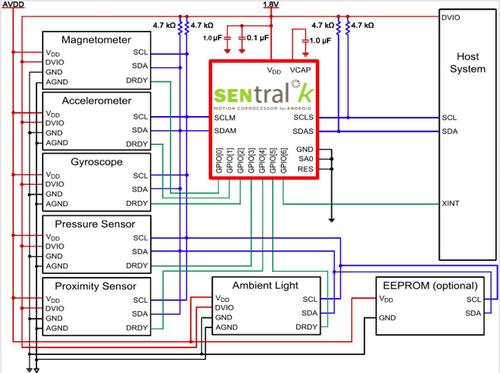

PORTLAND, Ore. -- The smallest, smartest, lowest power sensor hub implementing the complete set of "sensor.h" functions mandated by Google for the latest 4.4 "KitKat" version of its Android operating system for smartphones and tablets is claimed by PNI Sensor Corp. (Santa Rosa, Calif.). In a tiny 2-by-2 millimeter package consuming only 200 microAmps, PNI has implemented all the KitKat functions without the need of an external processor, greatly extending the battery live of Android devices even with all their 24/7 functions running.
"The other choices Android device manufacturers have is to write their own sensor fusion software running on, say, an Atmel or ARM Cortex 0 or Cortex 4 or license the sensor fusion software from others," Becky Oh, president and CEO of PNI, told EE Times. "Or they could buy smart sensors that implement some of the KitKat functions on-chip and run the rest on the application processor or a programmable sensor hub -- both of which will consume up to 10-times the power of our solution."

(Source: PNI)
Called SENtral-K (for KitKat), its trick is to use a tiny Synopsys ARC processor together with specialized state-machines to achieve 140,000 floating point operations per second while consuming under 200 microAmps of power at 1.8 volts. The SENtral-K is also sensor agnostic, allowing original equipment manufacturers (OEMs) to pick and choose from among the lowest power brands from all the different suppliers of accelerometer-, gyroscope-, magnetometer-, pressure-, proximity- and ambient-light-sensors.
SENtral-K fuses the outputs from these raw sensors to provide KitKat with the "sensor.h" functions it demands, including step-detect, step-count, linear acceleration, significant motion, and all the location-based and fused sensor outputs that Google wants to have available at all times for apps like Google Now.

(Source: PNI)
SENtral-K supports all Android 4.4 KitKat functions including nine degrees of freedom (DOF, 3-axis accelerometer, 3-axis gyro plus 3-axis magnetometer) 6 DOF (accelerometer plus gyro or accelerometer plus magnetometer), Gravity, Linear Acceleration, Step Detect/Count, Significant Motion, Calibrated Sensor, Un-calibrated Sensor, Data Batching, and Timestamp. PNI claims it uses 10-times less power that a flash-based MCU and costs about the same as a basic Cortex M0.
"In direct benchmarking comparisons with flash-based sensor-hub MCUs with on board floating point units," George Hsu, PNI's chairman of the board, told EE Times. "The SENtral-K operated at less than 10 times the power."
SENtral-K also has additional inputs for functions not specified in Google in KitKat, such as heart rate and humidity sensors, one run at 1.8 volts.
— R. Colin Johnson, Advanced Technology Editor, EE Times

